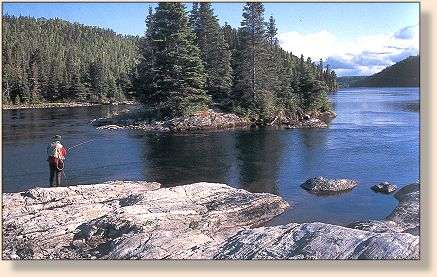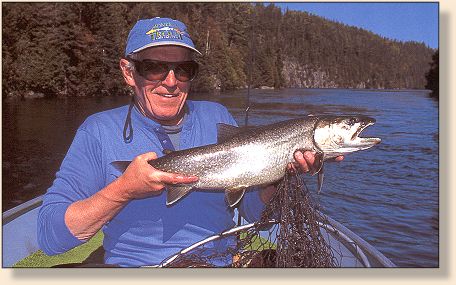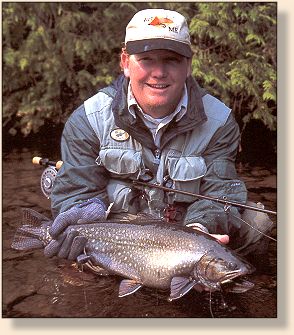Nipigon's Giant Brook Trout
By Scott E. Smith
From Ontario, Blue-Ribbon Fly Fishing Guide, Published
by Frank Amato Publications.
We appreciate use permission.
The Upper River
The brook trout of the Nipigon are large, unusually thick-shouldered
fish, on account of the richly productive waters of the system. A
system that at one time was an untethered river is now a tailwater
fishery created by three dams that were constructed during the first
half of the twentieth century. This harnessing of the river has
obviously changed and tamed the river. If you were old enough to
fish the river before and after the damming, you would hardly
recognize it, save for the clear, clean flows that are the
hallmark of the Nipigon.
Although this harnessing of the river has changed its nature
dramatically, there are inherent benefits with any tail-water
fishery. What was lost in brisk flows and thundering rapids
is gained in the intrinsic aquatic life brought about by the
productivity of dammed water. In addition, the reaches of river
above the dams are left untainted by the introduction of exotic
species to Lake Superior. There are no steelhead and salmon
anywhere above Alexander's Dam to compete with natural population
of brook trout, lake trout and whitefish.

The most effective way to fish the three upper stretches of the
Nipigon River are from a small boat or square stern canoe. One
would naturally assume that since the fish in the river are
bank-dwellers . . .that walk-and-wade tactics would suffice.
The problem is, there are very few places to wade and the high
canyon walls of the Nipigon make it almost impossible to walk
along the bank in places, never mind execute a back cast.
Subsequently, the technique that provides the most mobility
and ease of angling is to fish from a small boat either anchored
or held by the motor in the current. Fly fishing from a boat
held stationary in the current by a sputtering outboard may
seem sacrilegious to some but anchoring a boat successfully
and safely in twenty feet of swiftly flowing river is a guides
nightmare. I'll put up with the motor and save on the perils
of fooling with anchors and ropes in death-defying waters.
One of the best ways to fish the shoreline on the Nipigon is
a technique developed by River's Edge Fly Shop owner Bill Boote.
Bill holds the boat in the current with the motor, so that the
boat holds stationary or gradually drifts downstream. Casts
are made from a bow casting-platform toward the bank; almost
right to the bank in fact. Generally this brand of fishing
is of the streamer variety with a sink-tip or shooting head.
The fly is allowed to sink by employing a reach cast and large
mends immediately after the completion of the cast. Once the
fly reaches the appropriate depth, action is imparted to the
streamer as it completes the swing through a prime lie, such
as a current seam or behind a rock. When fishing this system,
takes are signified by the unmistakable jolt of the fly rod
that starts at the fly and rolls up the fly line like the
whip of a garden hose. Brook trout are rarely subtle when
taking a streamer. Newcomers to this type of fishing often
have trouble managing sink-tip lines, but after a little
practice, casts from fifty to seventy-five feet become routine.
After years of boat fishing Bill and I are quite adept at flinging
the entire fly line. Indeed the ability to cast great distances
are of primary importance anywhere on the Nipigon River.
A typical day of fishing on the big river involves fishing from
the boat with streamers on sink-tip lines throughout the day,
followed by an evening walk-and-wade sojourn on a gravel flat
during the often prolific hatch that precedes nightfall.
Fishing from the boat during a hatch seems to put the fish
down, perhaps because of the disturbances the boat makes
near the surface.

The upper reaches of the Nipigon River are defined by the
three concrete dams on the river: Alexander's, Cameron Falls
and Pine Portage.
As you travel north on Highway 585 from the town of Nipigon
on the Trans-Canada Highway, the first dam you encounter will
be Alexander's. Below the dam is the best stretch of
walk-and-wade water on the entire river (previously
covered here.)
Immediately above Alexander's is a lake-like widening of
the river; this is where the Frazer empties into the Nipigon.
Good fishing, both streamer and dry, is available in this
lake area along the rocky shore. Above this lake portion
and immediately below Cameron Falls Dam is a swift section
of the river. This is generally fished from shore, by hopping
from one rock to another and fishing downstream from your
position.
Above Cameron Falls Dam is another lake-like widening of the
river known as Jessie Lake. Jessie is renowned for both lake
trout and brook trout fishing. The latter of which are
concentrated around the islands and sunken reefs in the
middle of the lake. Incidentally, it is here on Jessie
Lake that while loading my boat onto the trailer one July
evening after a full day of fishing on the river, that I
encountered an incredible spinner fall of huge
Hexegenia limbata.
My fishing companion Bruce Miller and I, quickly stowed all
our heavy gauge streamer equipment and waded into the lake at
dusk with a floating six-weight and some large dries. We were
soon surrounded by large swirls made by voraciously feeding
brookies and whitefish. We fail to capitalize on this feast
due in part to the incredible hatch of mosquitoes that were
in turn feeding voraciously on us. In addition, we were
attempting to fish our normal twelve-foot dry-fly leaders
that sure enough, spent most of the fishing time wrapped
around one thing or another. I have since learned that
in order to fish the hex spinner fall successfully at night
you must fish a short leader with a stout tippet in order
to fish blind in these dark environs.
Jessie Lake is also productive walleye water, although at
the time of this writing walleye are still protected as a
result of a population crash in the 1970s.
Above Jessie Lake, which accounts for approximately 10 kilometers
of the Nipigon, is an 8-kilometer stretch of the river that
flows through a scenic canyon, at times three- to four-hundred
feet high. Within this stretch are several hot spots for brook
trout in the sixteen - to twenty-four inch range (two to eight
pounds), most of which are near portions of faster current and
underwater structure. In addition, catches of lake trout and
whitefish are common in this area. Both species attaining
respectable size: lakers up to ten pounds, and whitefish up
to seven or eight. This stretch of canyon water ends at Pine
Portage, the top dam on the Nipigon.
Upstream of Pine Portage Dam is where many of the largest brook
trout are still taken on the Nipigon system. Indeed the earliest
account of big fish - including the record fish- come from places
known as Virgin Falls and Rabbit Rapids, which are situated at
the top of the river almost 20 kilometers north of Pine Portage.
These famous spots are still there, although the original
river bed is many feet below the present water level.
Consistent with the other dams on the river, the portion
of river above Pine Portage Dam is a lake-like portion of
the river. This very large lake is known as Forgan Lake.
It runs to the northwest as the river proper runs northeast.
This situation makes the boat ride to the Virgin Falls area
a treacherous ride in windy weather. Subsequently, it is
best to travel in a larger craft from Pine Portage north.
As one would expect, the rewards available in the Virgin
Falls areas, just below Lake Nipigon, can be awesome, both
in catch and scenery.
 Not unlike hot apple pie and ice-cream after a long day's
fishing, I've saved the best part . . .for the end: the
brook trout itself.
Not unlike hot apple pie and ice-cream after a long day's
fishing, I've saved the best part . . .for the end: the
brook trout itself.
The brook trout of the upper Nipigon are a sight to behold.
They are beautifully detailed like no other fish I have ever
seen. Brilliant orange spots with striking blue halos are
the signature markings of these fish. They appear silver
in the water, especially on a sunny day, but once you examine
them closely, as you gently pull the hook from their mouth
and prepare to release them, you will notice their matchless,
breathing beauty.
As I mentioned previously, they are very thick in the body,
especially the denizens of the upper river. So much that
regular formulas for calculating a trout's weight do not
apply to these brook trout . . .They are not, however,
chunky to the extent of being portly or sluggish. In fact,
they remain streamlined for their size and fight with a
vengeance; eager to run far into your backing in the big
river.
This large girth-to-length proportion is naturally due to the
amount and type of feed in the river. It would be interesting
to compare the proportions of these modern fish to those that
existed prior to the damming of the river. ~ Scott E. Smith
Next time: Hatches and Flies!
Our Man In Canada Archives
|



 Not unlike hot apple pie and ice-cream after a long day's
fishing, I've saved the best part . . .for the end: the
brook trout itself.
Not unlike hot apple pie and ice-cream after a long day's
fishing, I've saved the best part . . .for the end: the
brook trout itself.